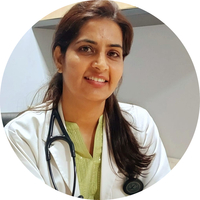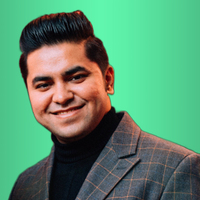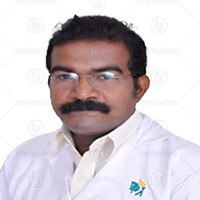Summary
Cardiomyoplasty is a surgery for the treatment of heart failure. It was earlier done by taking a muscle from the back or abdomen and wrapping it around the heart (dynamic cardiomyoplasty) but now it is performed by injecting cells into the damaged part of the heart (cellular cardiomyoplasty). Heart failure is characterised by the inadequacy of the heart to pump blood throughout the body. A heart transplantation can be done to manage this condition; however, the difficulty of finding a donor or meeting the selection criteria for heart transplantation can lead to the need for other procedures like cardiomyoplasty.
Before cardiomyoplasty, your healthcare provider may ask you to undergo a few diagnostic tests to check your overall health.
It may take about 15 minutes to perform a cellular cardiomyoplasty. After the procedure, once you reach home, you must take proper care of your wound, and take your medications regularly for a smoother recovery.
- What is cardiomyoplasty?
- Why is cardiomyoplasty recommended?
- Who can and cannot get cardiomyoplasty?
- What preparations are needed before cardiomyoplasty?
- How is cardiomyoplasty done?
- How to care for yourself after cardiomyoplasty?
- What are the possible complications/risks of cardiomyoplasty?
- When to follow up with your doctor after a cardiomyoplasty?
What is cardiomyoplasty?
Cardiomyoplasty is a surgical procedure performed to manage heart failure.
Heart failure is also known as congestive heart failure. In this condition, the heart is not able to pump blood efficiently throughout the body. The condition may worsen over the years and limit your daily activities. A heart transplantation can help manage heart failure; however, due to the shortage of donors and difficulty meeting eligibility criteria, other methods such as cardiomyoplasty are considered.
Initially, dynamic cardiomyoplasty, in which a muscle from the abdomen or back is taken and wrapped around the heart to aid in heart function, was one of the methods used for cardiomyoplasty; however, this procedure is no longer performed as it did not show significant benefits. This procedure is now replaced with cellular cardiomyoplasty. Cellular cardiomyoplasty involves injection or delivery of certain type of cells called stem cells into the damaged part of the heart. These cells help replenish myocardial cells (cells in the heart muscle), thus improving heart function and symptoms of heart failure.
Why is cardiomyoplasty recommended?
Cardiomyoplasty may be performed if you show the following symptoms of heart failure:
- Swelling in the ankles and legs
- Difficulty breathing
- Frequent cough that worsens at night
- Loss of appetite
- Fatigue
- Confusion
- Irregular heartbeat or pounding heartbeats
- Weight gain or loss
- Bloated tummy
- Fast heart rate
- Dizziness
- Anxiety
Who can and cannot get cardiomyoplasty?
Cardiomyoplasty may be contraindicated in the following conditions:
- If the muscle of your heart is thinner than 5mm, cellular cardiomyoplasty by catheter-based injection method is contraindicated as there is a risk of perforation of the heart muscle.
- If you cannot undergo magnetic resonance imaging (MRI) test, you may not be eligible for cardiomyoplasty procedures that require an MRI for correct placement of the stem cells.
- You may not be able to have this procedure if you have kidney failure and need dialysis, a blood disorder, current or prior cancer, prior heart surgery, left ventricular aneurysm, preoperative steroid therapy, valvular disease requiring surgery, or are within 6 days of an acute coronary event.
What preparations are needed before cardiomyoplasty?
Before undergoing this surgery, you will need the following preparation:
- Your healthcare provider may ask you to undergo a few diagnostic tests to review your overall health. These include:
- Chest X-ray
- Blood tests
- Pulmonary function tests (to measure the function of your lungs)
- Electrocardiogram (to check the electrical movement of the heart)
- Ultrasound study
- Computed tomography (CT) scan
- MRI
- Share a list of all the medications that you take, including prescribed or non-prescribed medicines, minerals, herbs, vitamins, and supplements with your doctor. Your doctor may advise you to stop taking blood-thinning medicines like warfarin, clopidogrel, aspirin, or ibuprofen.
- Tell your doctor if you take any illegal drugs, alcohol, or smoke cigarettes. He/she may ask you to quit these habits before the procedure to ensure quicker recovery afterwards.
- Arrange for a ride to take you home after the surgery.
- You will be asked for your medical history including questions about any recent illnesses or allergies to medicine, food, or surgical components like iodine, skin tapes, or skin-cleansing solution.
- The doctor will ask you to fast from midnight before the surgery.
- You will need to sign a consent form to grant permission for the surgery.
How is cardiomyoplasty done?
In this procedure, the surgeon injects different stem cells such as embryonic, bone marrow, or skeletal muscle cells into the heart to replace damaged cells.
Once you reach the hospital, the medical staff will provide you with a hospital gown. They will start an intravenous (IV) line in your arm to give you medicines during the surgery. An anesthesiologist will administer general anaesthesia to put you to sleep during the surgery. A healthcare practitioner will shave the surgical area and clean it using an antiseptic solution. This will help reduce the risk of infections.
Then, the surgeon will use one of the following methods to deliver stem cells to your heart:
Epicardial or endovascular delivery approach:
This is performed using the conventional or mini-thoracotomy method as follows:
- The surgeon will make an incision (cut) over your chest bone to expose the area where the injection is to be given.
- He/she will then give you several injections of the cell solution in heart muscle to implant cells inside your heart.
- A majority of the cell solution is injected around the damaged part of the heart with some portion in the central portion of the damage.
- After every injection, the surgeon will press the injection site with fingers to avoid leakage of the cell solution.
- Once all the cell solution is injected, the surgeon will close the cut using sutures.
Catheter-based cell implantation:
In this procedure, a catheter (thin tube) will be used to deliver cells into the heart. The surgeon may use the assistance of an MRI to correctly place the catheter. The cells are delivered by any of the following methods:
- Intracoronary approach: A catheter is used to deliver cells into a blood vessel of the heart, which will then carry the cells to the damaged heart muscle. This procedure requires special type of cells like bone marrow and blood progenitor cells.
- Intramyocardial approach: The cells will be delivered inside the heart muscle either by needle injection or catheter.
- Intravenous approach: The cells are delivered through a catheter placed in a vein, which will deliver the cells to the heart.
It may take about 15 minutes to inject cells inside the heart. When you wake up after the surgery, you will have a tube inside your nose to supply oxygen. A nurse will give you medicines for pain. You will be able to consume liquids after the procedure. Your doctor will monitor your health carefully after discharge as ventricular arrhythmia (abnormal heartbeats) can be seen in the first two weeks after a cardiomyoplasty.
How to care for yourself after cardiomyoplasty?
Once you are home, you will need to take the following care:
- Wound care:
- Avoid applying lotion or cream on the incision area.
- You should not soak your wound while bathing for about six weeks. The doctor may permit you to shower.
- Make sure the area is clean and dry.
- Wear loose-fitted clothes.
- Medications:
- The doctor will prescribe medications to reduce your pain after the surgery.
- You will also have to take antiarrhythmics (used to treat abnormal heart rhythm) following the procedure.
- Activities:
- Your doctor may advise a few exercises to help you recover faster
- He/she may also advise you to start walking for at least five to 10 minutes each day.
- Avoid lifting heavy objects for the initial few weeks.
- You can resume your routine work after six to 12 weeks.
- The doctor will tell you when it is safe to travel again after the surgery.
When to see the doctor?
You must immediately inform your healthcare provider if you are experiencing the following symptoms after the surgery:
- Fever
- Chest pain
- Bleeding from the wound area or pain, redness or warmth at the incision site
- Sudden weakness or numbness in the extremities
- Chills
- Fast heart rate
- Difficulty breathing
When to follow up with your doctor after a cardiomyoplasty?
You will have a follow-up appointment every three months during the initial year after your surgery, and later in every six months for postoperative evaluation.
Disclaimer: The above information is provided purely from an educational point of view and is in no way a substitute for medical advice by a qualified doctor.
Surgery Cost In Your City
Doctors for Cardiomyoplasty

Dr. Manju
Cardiology
10 Years of Experience

Dr. Farhan Shikoh
Cardiology
11 Years of Experience

Dr. Amit Singh
Cardiology
10 Years of Experience

Dr. Shekar M G
Cardiology
18 Years of Experience
References
- Bocchi EA. Cardiomyoplasty for treatment of heart failure. Eur J Heart Fail. 2001 Aug;3(4):403–406. PMID: 11511424.
- Lamb EK, Kao GW, Kao RL. Cellular cardiomyoplasty: its past, present, and future. Methods Mol Biol. 2013;1036:1–17. PMID: 23807782.
- Buja Maximilian, Butany Jagdish. Cardiovascular pathology. 4th ed. Elsevier; 2016.
- National Health Service [Internet]. UK; Heart failure
- Al Kindi A, Ge Y, Shum-Tim D, Chiu RC. Cellular cardiomyoplasty: Routes of cell delivery and retention. Front Biosci. 2008;13:2421-2434. PMID: 17981723.
- Federico B, Scialacomo N, Mariani E, Geffner L, Eng BB, et al. Surgical Implantation of Stem Cells in Heart Failure Patients due to Idiopathic Cardiomyopathy. J Stem Cell Ther Transplant. 2017;1:017-027
- Neumayer L, Ghalyaie N. Principles of preoperative and operative surgery. In: Townsend CM Jr, Beauchamp RD, Evers BM, Mattox KL, eds. Sabiston Textbook of Surgery: The Biological Basis of Modern Surgical Practice. 20th ed. Philadelphia, PA: Elsevier; 2017:chap 10
- Michigan Medicine [internet]. University of Michigan. US; Tests Prior to Surgery
- Smith SF, Duell DJ, Martin BC, Aebersold M, Gonzalez L. Perioperative care. In: Smith SF, Duell DJ, Martin BC, Gonzalez L, Aebersold M, eds. Clinical Nursing Skills: Basic to Advanced Skills. 9th ed. New York, NY: Pearson; 2016:chap 26.
- Island Health [Internet]. British Columbia. Canada; Before during and after heart surgery
- Stanford Healthcare [Internet]. University of Stanford. California. US; Before Your Heart Surgery
- The Royal Marsden [Internet]. NHS Foundation Trust. National Health Service. UK; Consent for surgery
- Chachques JC, Acar C, Herreros J, Trainini JC, Prosper F, D’Attellis N, et al. Cellular cardiomyoplasty: clinical application. Ann Thorac Surg. 2004;77(3):1121–1130
- Johns Hopkins Medicine [Internet]. The Johns Hopkins University, The Johns Hopkins Hospital, and Johns Hopkins Health System; Preparing for Surgery: The Operating Room
- El Oakley RM, Jarvis JC. Cardiomyoplasty: a critical review of experimental and clinical results. Circulation. 1994 Oct;90(4):2085–2090
- Cleveland Clinic [Internet]. Ohio. US; Minimally Invasive Heart Surgery: Procedure Details
- UCSF Health [Internet]. University of California San Francisco. California. US; Endovascular Surgery
- L, Goodchild T, Gadesam RR, Chen J, Robinson K, Chronos N, et al. Cellular cardiomyoplasty and cardiac regeneration. Curr Cardiol Rev. 2008 May;4(2):72–80. PMID: 19936280.
- Sheng CC, Zhou L, Hao J. Current stem cell delivery methods for myocardial repair. Biomed Res Int. 2013;2013:547902. PMID: 23509740.















